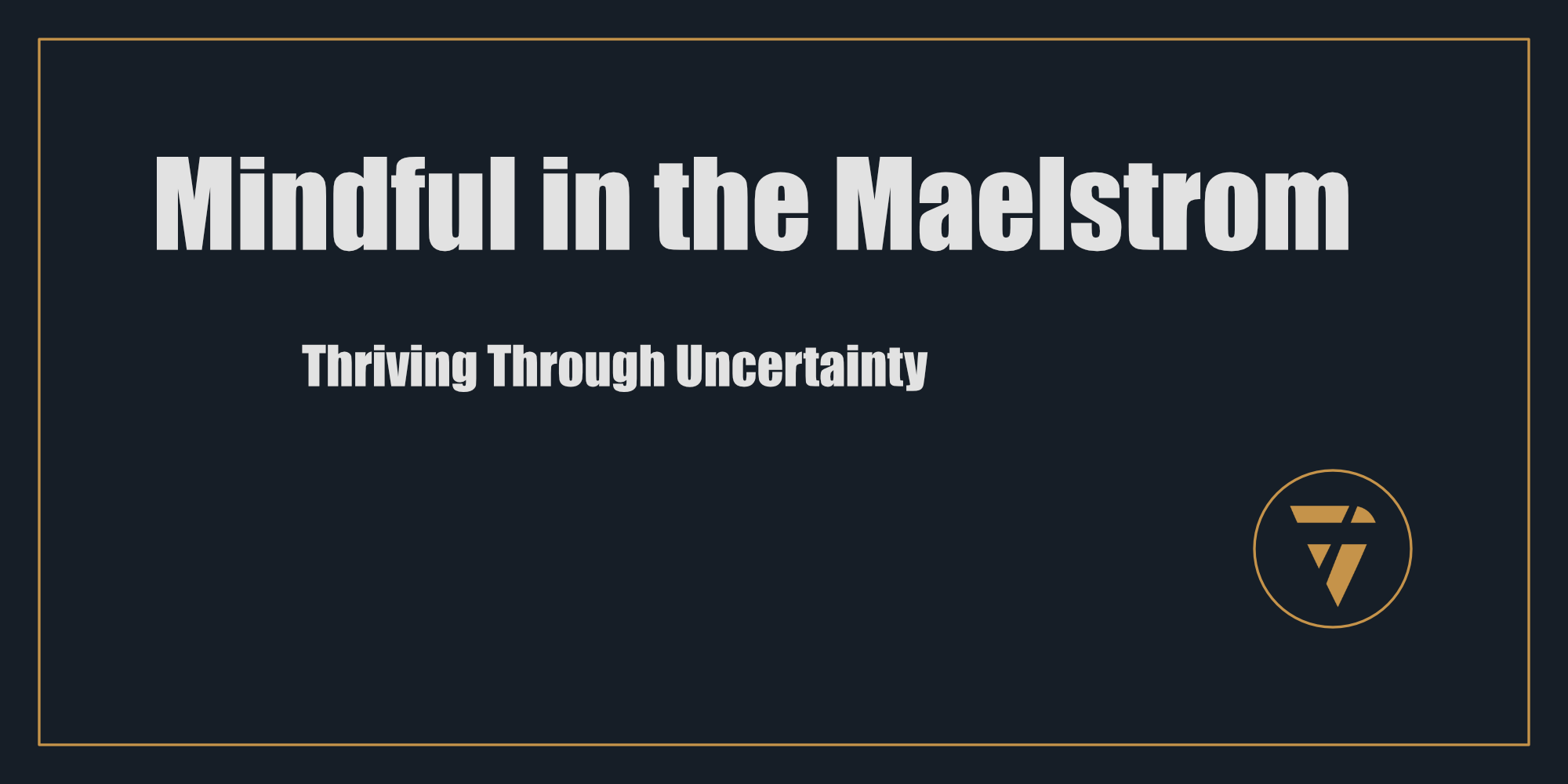Mindful in the Maelstrom
Thriving Through Uncertainty

Life’s most profound transformations often emerge from its most turbulent moments. The chaos we instinctively resist often holds the seeds of our greatest growth, if we know how to face it. What if, instead of fearing uncertainty, we embraced it as a teacher?
The Power of Embracing Chaos
Uncertainty is the backdrop of modern life. From economic instability, to rapid technological shifts and global disruptions, ambiguity seems to be the only constant. This uncertainty often fuels stress, fear, and paralysis, leaving us clinging to the illusion of control.
Yet, history teaches us that those who thrive in the maelstrom aren’t the ones who resist it, but those who adapt, grow, and harness its energy. This is where mindfulness becomes a game-changer.
Mindfulness offers more than just stress relief; it equips us to navigate the unknown with clarity and courage. By grounding ourselves in the present, we transform uncertainty into opportunity, chaos into creativity, and fear into focus. Explore how practical mindfulness techniques help us thrive amidst ambiguity.
1. Reframing Uncertainty as Opportunity
The human brain is wired to dislike ambiguity. Our survival instincts equate the unknown with danger. However, this reaction is outdated in a world where uncertainty often signals possibility.
Key Insight:
Uncertainty isn’t inherently bad, it’s a blank canvas. Mindfulness helps us reframe ambiguity as a space for growth and innovation.
Example:
Consider Thomas Edison’s approach to invention. Each failure wasn’t a setback, but a step closer to success. His ability to remain present and open to new possibilities amid uncertainty was key to his breakthroughs.
Practice:
- The Mindful Reframe: When faced with uncertainty, write down three potential opportunities the situation might present. This shifts your mindset from fear, to curiosity.
2. The Anchor in the Storm: Presence
Amid the chaos, mindfulness acts as an anchor. By focusing on the present moment, we stabilize ourselves, reducing the overwhelm of uncertainty.
Mindful Presence Techniques:
- Five-Breath Focus: When anxiety spikes, take five deep breaths, inhaling for a count of four, holding for four, and exhaling for six. This calms your nervous system and grounds your awareness.
- Sensory Check-In: Pause and identify one thing you can see, hear, touch, taste, and smell. This exercise brings you back to the present.
Case Study:
During the pandemic, leaders who implemented mindfulness practices within their teams reported higher resilience and adaptability. By teaching presence, they empowered their teams to tackle challenges without succumbing to panic.
3. Mindfulness as a Decision-Making Tool
Uncertainty often leads to analysis paralysis, where too many unknowns hinder action. Mindfulness simplifies decision-making by reducing noise and focusing on what truly matters.
Key Insight:
Mindfulness sharpens decision-making by helping us separate what we can control from what we cannot.
Framework for Mindful Decisions:
- Pause: Step back and resist the urge to react immediately.
- Assess: Identify what is known and unknown.
- Prioritize: Focus on the most critical variables.
- Act: Make the best decision with the information available, knowing you can adjust as needed.
Practice:
- Mindful Journaling for Decisions: Write down the pros and cons of a decision, then reflect on how each aligns with your long-term goals. Journaling reduces emotional reactivity and clarifies priorities.
4. Turning Chaos into Creativity
Some of history’s greatest innovations were born in periods of uncertainty. Chaos disrupts routines, forcing us to think differently. Mindfulness amplifies this creativity by fostering openness and curiosity.
Example:
During the Great Depression, businesses like Procter & Gamble innovated new products (Ivory Soap) to meet changing consumer needs. Their success came from viewing chaos as an opportunity, not a barrier.
Practice:
- The Beginner’s Mind Exercise: Approach challenges as if you were seeing them for the first time. Ask: “If I had no preconceptions, what solutions might I see?”
Most of what I do, is seeing what other people can’t see yet.
5. Building Resilience Through Mindful Practice
Resilience isn’t about avoiding difficulty, it’s about bouncing back stronger. Mindfulness builds resilience by teaching us to embrace discomfort without being consumed by it. We’re going to have to do a lot of bouncing back…
Key Insight:
Mindful resilience focuses on responding to challenges rather than reacting to them.
Practices for Resilience:
- Gratitude Pause: Each evening, list three things you’re grateful for, even during tough times. Gratitude rewires the brain for positivity.
- Visualization: Picture yourself successfully navigating a current challenge. This primes your brain for action.
Case Study:
Athletes often use visualization to build resilience. Olympian Michael Phelps visualized every possible scenario, including failure, to prepare mentally for uncertainty.
Action.
- Reframe Uncertainty: View ambiguity as a space for growth and opportunity.
- Anchor in the Present: Use mindfulness techniques like breathwork and sensory grounding to reduce overwhelm.
- Simplify Decisions: Focus on what you can control and act with clarity.
- Foster Creativity: Approach challenges with curiosity and an open mind.
- Build Resilience: Practise gratitude and visualization to navigate tough times.
What if the uncertainty you’re facing right now is your greatest teacher? How can mindfulness help you embrace the chaos? Share your thoughts.
Uncertainty is a constant, but it doesn’t have to be a barrier. Subscribe for more mindfulness strategies, and explore how to integrate these practices into your life or organization. Together, we can turn chaos into a catalyst for growth.
In the maelstrom of life, mindfulness is your compass, guiding you through uncertainty with clarity and courage.
This Substack is reader-supported. To receive new posts and support my work, consider becoming a free or paid subscriber.
This is what I’m working on. Tell me what you think, I enjoy the conversation! Subscribe and follow the work in real time.
Thanks!
B
Chaos demands reaction. Wisdom chooses the response. Be mindful, and let the storm sharpen your resolve.
PS -





